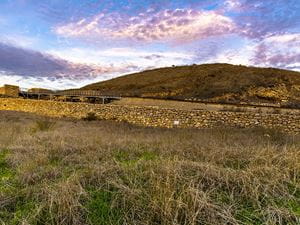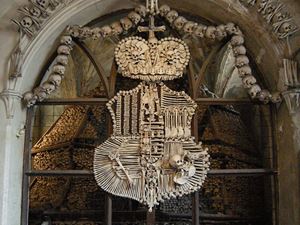Many people have claimed that the history laid out in the Bible is pure fantasy. They have claimed that Moses did not exist and that the Exodus did not occur as there is no physical evidence of the Israelites wandering the desert. People have argued that Jesus could not have been buried as Scripture claims because the Romans did not grant honorable burials to executed criminals. Over and over, the skeptics have pointed out events in the Bible for which there is no physical proof.
In response to skeptics, Christians have argued that some events would not necessarily leave behind evidence that was capable of surviving multiple millennia for modern scholars to examine. Desert nomads rarely leave behind evidence of their presence, much less artifacts that would survive centuries. Ancient cities all over the globe were lost to time, that does not mean they did not exist in the first place. Faithful scholars have also pointed out that there is textual evidence of such events: the Bible. Under other circumstances, the Bible might have been considered a useful source. Its accuracy would have been debated, but the accounts contained within would have been seen as helpful in reconstructing an ancient culture, just as Greek myths and Mesopotamian lore help scholars reconstruct those ancient societies.
Skeptics held the upper hand for much of this debate, simply by demanding concrete proof and ignoring the fact that much of modern understanding is based on circumstantial evidence and reasonable guesses. Recently, however, historical scholarship and archaeology have begun to topple some of skeptics’ favorite theories with finds that cannot be dismissed. Here are five times history backed up the Bible.
In response to skeptics, Christians have argued that some events would not necessarily leave behind evidence that was capable of surviving multiple millennia for modern scholars to examine. Desert nomads rarely leave behind evidence of their presence, much less artifacts that would survive centuries. Ancient cities all over the globe were lost to time, that does not mean they did not exist in the first place. Faithful scholars have also pointed out that there is textual evidence of such events: the Bible. Under other circumstances, the Bible might have been considered a useful source. Its accuracy would have been debated, but the accounts contained within would have been seen as helpful in reconstructing an ancient culture, just as Greek myths and Mesopotamian lore help scholars reconstruct those ancient societies.
Skeptics held the upper hand for much of this debate, simply by demanding concrete proof and ignoring the fact that much of modern understanding is based on circumstantial evidence and reasonable guesses. Recently, however, historical scholarship and archaeology have begun to topple some of skeptics’ favorite theories with finds that cannot be dismissed. Here are five times history backed up the Bible.
The House of David

Oren Rozen/Wikicommons
Biblical skeptics have repeatedly demoted some of the most important figures in the Bible to nothing more than fictional characters. Israel, Joseph, Moses and David have all been declared by skeptics to be nothing more than products of an ancient revisionist imagination. Christian, Jewish and even some Muslim scholars argued that such people were most definitely real.
The debate raged for years, but skeptics tended to hold the upper hand. Then, a broken stele was unearthed at Tel Dan in northern Israel. The inscription was written by a victorious king bragging of his victory over his rivals, the “king of Israel” and the “king of the House of David.”
This singular mention of one of the Bible’s greatest kings is the only evidence found outside the Bible that speaks of David’s existence, but it is hard to argue with ancient stone. Skeptics have still tried to argue that the “David” referred to on the stele is a place, not a person, but most scholars and archaeologists accept the inscription as proof that David truly existed.
Hittite Monuments

Shutterstock.com
According to biblical skeptics, the writers of the Old Testament were not merely content with inventing prophets and kings out of thin air, they also invented entire cultures to serve as a fictional enemy for their imaginary kings. This, skeptics claimed, was the origin of the Hittites. The Hittite people were not an ancient culture but a mythical group invented by storytellers. This belief, however, was flipped on its head rather suddenly when Hittite monuments were uncovered along the Euphrates River. Alongside these ancient monuments were thousands of Hittite documents that recorded not just Hittite history, but the people’s culture as well. Cuneiform tablets were uncovered and even the ancient capital of the Hittite Empire was unearthed. These artifacts proved that, far from being an imaginary enemy, the Hittites were once one of the dominant peoples in the Middle East and controlled an area the covered parts of modern day Turkey, Syria and Israel.
Babylonian Captivity

Shutterstock.com
According to biblical skeptics, the Babylonian captivity was nothing but a fairy tale. This sneering theory had the rug ripped out from under it when an ancient city was discovered 30 miles southwest of Jerusalem. The broken walls were believed to be the remains of the ancient city of Lachish, a Judean stronghold that was besieged and broken by Babylon. Among the ruins were hundreds of arrowheads, more than 1,500 human skulls and 21 pottery fragments carrying Hebrew inscriptions describing the battle that were written during the siege. Other ruins nearby were found to contain largely intact pottery from where Judean people dropped what they had and fled the approaching army. This excavation layer was marked by thick, dark ash from where Sennacherib burned the cities to the ground.
Proof of the Babylonian captivity was not found purely in Israel either. When Sennacherib’s palace in Nineveh in modern day Iraq was discovered, a series of palace reliefs were also unearthed. These 40 foot wide reliefs depicted the brutal siege and gruesome slaughter of the inhabitants of Lachish. An inscription on the relief read “Sennacherib, the mighty king, king of the country of Assyria, sitting on the throne of judgment, at the entrance of the city of Lachish. I give permission for its slaughter.”
Biblical Cities

Shutterstock.com
The Old Testament was not the only section of the Bible under siege from skeptics. The New Testament was targeted for scorn as well. One piece of the New Testament that was questioned repeatedly was the very existence of Nazareth. The town was so small that it was not mentioned until after Jesus’ death. This led many skeptics to claim that the village did not exist during Jesus’ lifetime.
Archaeology and history, however, both prove that Nazareth was very real during the time of Christ. Jewish sources from the 1st century A.D. contain mentions of Nazareth. Nazareth itself was also uncovered by archaeologists. The ruins dated back to the first century. The types of tombs discovered in the village showed that the settlement was heavily Jewish. In 2009, a full house was unearthed for the first time in Nazareth. The building was described as “small and modest” by the excavation director, Yardenna Alexandre, but the home is “likely typical of the dwellings in Nazareth [during Jesus’ life.]” Other biblical cities that were discovered despite their supposed fictitious quality include Lachish and Rimmon.
James, Son of Joseph, Brother of Jesus

Milan Boers/Flickr
According to the Bible, James, the brother of Jesus, was martyred in A.D. 62. In 2002, an ossuary from the middle of the 1st century was discovered within the vicinity of Jerusalem. Ossuaries are stone boxes that were used by ancient Jews to hold the bones of the dead. Corpses would be laid in tombs whole, but after the flesh and skin had decomposed, the bones would be placed in an ossuary that was as long as the femur, wide as the pelvis and tall as the skull. In this way, a tomb could hold many generations of a family in a relatively small amount of space. Ossuaries are found relatively often in Israel, but what made this one so unique was the inscription it carried: “Ya’akov bar Yosef akhui di Yeshua.” Translated, the ancient inscription says “James, son of Joseph, brother of Jesus.”
Biblical scholars and everyday Christians alike were in an uproar. Skeptics naturally claimed that the inscription was a forgery. The inscription was authenticated by world renowned paleographers, Andre Lemaire and Ada Yardeni, specialists in dating, interpreting and authenticating inscriptions. Their interpretation has not been challenged by any other paleographer, despite claims of forgery, and even one of the skeptics admitted under oath that there was original ancient patina on the word “Jesus.” This would make the inscription the oldest reference to Jesus ever found.
As much as skeptics would love to claim that the history laid out in the Bible is pure nonsense, the body of evidence supporting biblical claims is growing too large to ignore. Names of “fictitious” kings have been found inscribed by their enemies, “made-up” cities have been uncovered and evidence of events that were “pure ancient propaganda” have been found. Time and again history and archaeology have joined forces to uphold the truth of the most famous book of all. They have shown that the Bible is more than a series of interesting stories, it is truly history.
